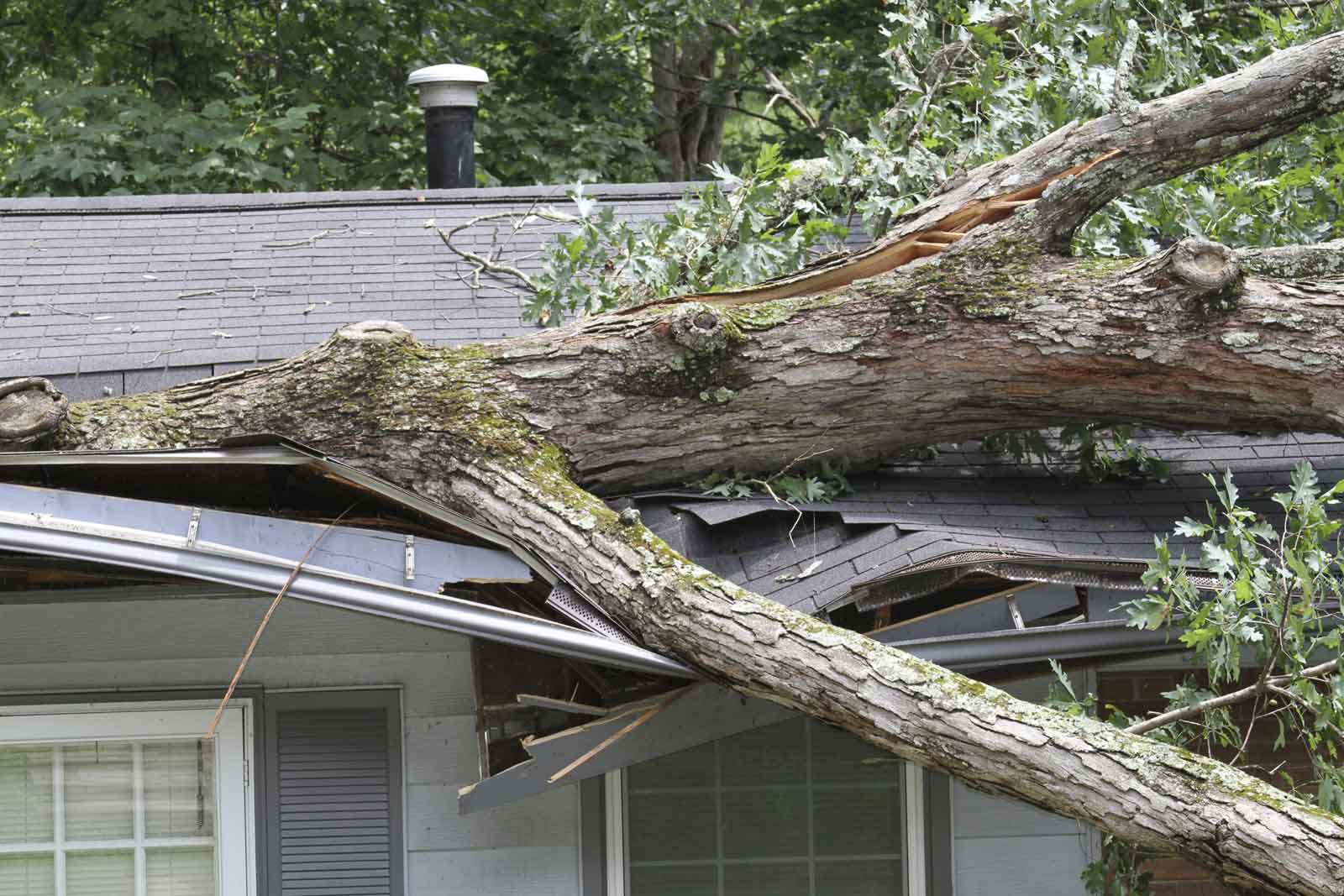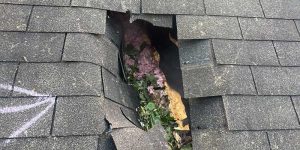 Imagine waking up in the middle of the night to a loud crash, only to discover that a tree has fallen on your roof. It’s a scenario that no homeowner wants to experience, but it’s more common than you might think. Whether it’s due to severe weather, disease, or simply the age of the tree, a fallen tree can cause significant damage to your home. Understanding what to do when a tree falls on roof and how to prevent it from happening again is crucial.
Imagine waking up in the middle of the night to a loud crash, only to discover that a tree has fallen on your roof. It’s a scenario that no homeowner wants to experience, but it’s more common than you might think. Whether it’s due to severe weather, disease, or simply the age of the tree, a fallen tree can cause significant damage to your home. Understanding what to do when a tree falls on roof and how to prevent it from happening again is crucial.
What to Do if a Tree Falls on Your House due to an “act of God”
Imagine waking up in the middle of the night to a loud crash, only to discover that a tree has fallen on your roof. It’s a scenario that no homeowner wants to experience, but it’s more common than you might think. Whether it’s due to severe weather, disease, or simply the age of the tree, a fallen tree can cause significant damage to your home. Understanding what to do in such a situation and how to prevent it from happening again is crucial.
Immediate Steps to Take When a Tree Falls on Your Roof
Ensure Safety First
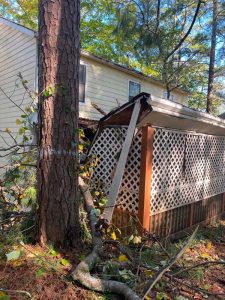 Your safety and the safety of your loved ones should be your top priority. If a tree has fallen on your roof, the first thing you should do is make sure everyone in the house is safe. Avoid the area where the tree has impacted the roof, as there could be structural damage that could lead to further collapse.
Your safety and the safety of your loved ones should be your top priority. If a tree has fallen on your roof, the first thing you should do is make sure everyone in the house is safe. Avoid the area where the tree has impacted the roof, as there could be structural damage that could lead to further collapse.
Evacuate the House
If the damage appears severe or if you’re unsure about the safety of staying inside, evacuate the house immediately. It’s better to be cautious in these situations, especially if there’s a risk of the roof caving in or if electrical lines have been damaged.
Call Emergency Services
Once everyone is safe, contact your local emergency services. They can assist in assessing the immediate danger, such as downed power lines or significant structural damage. If you’re unable to leave the house safely, they can help you evacuate.
Call your insurance company
While you’re waiting safely outside the house, you can take a moment to call your insurance company. Just as you did with the local emergency services, let them know that a tree fell over your house and ask them what you need to do. They will guide you through the process of filing a claim and may provide immediate assistance with emergency repairs.
Find out if your home is safe enough to remain or if you need to find temporary housing
To answer this question, you must consult with the emergency services teams, your insurance company, and your landlord (if you are renting). Insurance will often cover temporary living arrangements, such as a nearby hotel.
Document the Damage
Before any repairs are made, take photos and videos of the damage. This documentation will be important when filing your insurance claim. Make sure to capture the extent of the damage to both the interior and exterior of your home.
You need a local roofing company
If a tree falls on roof, call a local roofing company to inspect your roof to determine if it needs roof repair or a full roof replacement. We service the entire Metro Atlanta, GA and our phone number is 678-766-9646. Contact us today for a free evaluation after a tree fell on your house.
Assessing the Damage of a Tree Fallen on Your House
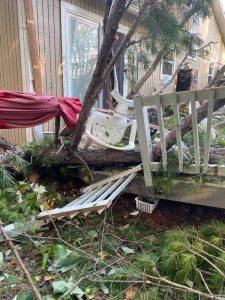 Once everyone is safe, look at the tree and your house. This is easier done in the daylight, but if you have a good flashlight, you should understand what you’re dealing with. If the tree has pulled down power lines or is at risk of damaging gas lines, turn off the main breaker in your home’s breaker box or the gas line at the meter.
Once everyone is safe, look at the tree and your house. This is easier done in the daylight, but if you have a good flashlight, you should understand what you’re dealing with. If the tree has pulled down power lines or is at risk of damaging gas lines, turn off the main breaker in your home’s breaker box or the gas line at the meter.
Inspecting the Extent of Damage
Once the situation is under control, you can begin to assess the damage. This may involve checking for leaks, cracks in the walls, and any other signs that the structure of your home has been compromised.
Understanding Structural vs. Cosmetic Damage
It’s important to distinguish between structural and cosmetic damage. Structural damage affects the integrity of your home and needs immediate attention, while cosmetic damage, such as broken shingles or damaged gutters, can typically be addressed later.
Temporary Repairs
Covering the Roof with a Tarp
If it’s safe to do so, consider covering the damaged area of your roof with a tarp. This will help protect your home from further damage caused by rain or debris. However, be cautious and only attempt this if you’re certain the roof is stable.
Securing Broken Windows and Doors
If the tree has broken any windows or doors, secure them with plywood or heavy plastic to keep the elements out and maintain the security of your home.
Removing trees and tree branches
Homeowners can save money by cutting up a fallen tree themselves and then hiring someone to remove the logs and branches. However, unless they are skilled with a chainsaw, it’s best to leave tree removal to professionals.
If homeowners are using chainsaws, they need to follow some basic safety instructions. This might save somebody’s leg or life.
There are simple steps that can significantly reduce injuries from chainsaws:
- Wearing protective chaps
- Safety glasses
- Chainsaw helmet with earmuffs and protective screen.
These chaps and other chainsaw safety products, available at local retailers like Lowe’s, Home Depot and online, Amazon and others, are made of material that can stop a chainsaw blade even at full speed without bruising the skin. Protective glasses will help prevent eye injuries from flying splinters.
Cutting up a fallen tree is not a DIY project for amateurs. You might save money on tree removal, but you could end up paying for an emergency room visit. Cutting trees is very dangerous, especially in storm situations. It depends on the skill.
Even those experienced with power tools need to take precautions before tackling a fallen tree. Whenever trees are down, the first thing to do is look for power lines. Believe it or not, trees conduct electricity, and every year many people are electrocuted by touching a branch that is also touching a live power line.
Also, be careful about branches bent beneath a fallen tree. They can have a powerful spring effect. Another common injury occurs when someone cuts a branch, and the tree shifts because of the reduced weight, potentially causing serious injury or death.
Choosing a Professional Roof Repair Service when a Tree Falls on Roof
Finding a Reliable Contractor
When it comes to repairing your roof, you’ll want to find a reliable contractor. Look for someone with experience in handling similar situations and who comes highly recommended.
What to Look for in a Roof Repair Specialist
Check for proper licensing and insurance, read reviews, and ask for references. A good contractor should be able to provide you with a detailed estimate and timeline for the repairs.
Getting Multiple Quotes
It’s always a good idea to get multiple quotes before settling on a contractor. This ensures that you’re getting a fair price and helps you gauge the level of service you can expect.
Trust the Pros for Quality Emergency Tree Damage Repairs
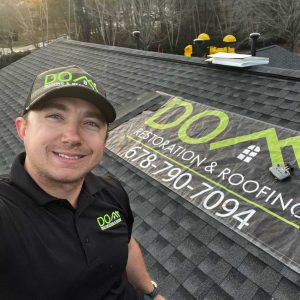 Get fast and effective emergency roof, gutters, siding, and other repairs after a tree falls with the #1 Atlanta area roofing company to ensure you and your property get the attention and care you deserve. We are the best roofing contractor in Metro Atlanta, GA, with offices in Sugar Hill and Suwanee, and serve the entire Metro Atlanta Area, GA area including Suwanee, Alpharetta, Sugar Hill, Johns Creek, Buford, Norcross, Duluth, Lawrenceville, Flowery Branch, Dacula, Cumming, Roswell, Woodstock, Marietta, Kennesaw and more.. We know the local area, including the architecture and the seasonal weather changes. This makes them the better choice to help create sustainable fixes that hold up long-term. Our company’s name is DOM Roofing & Restoration because our mission is to restore and improve your home and make every customer feel comfortable and safe in their home after storm damage, tree damage, high winds, and others. We can repair your gutters, siding, framing, and other emergency repairs.
Get fast and effective emergency roof, gutters, siding, and other repairs after a tree falls with the #1 Atlanta area roofing company to ensure you and your property get the attention and care you deserve. We are the best roofing contractor in Metro Atlanta, GA, with offices in Sugar Hill and Suwanee, and serve the entire Metro Atlanta Area, GA area including Suwanee, Alpharetta, Sugar Hill, Johns Creek, Buford, Norcross, Duluth, Lawrenceville, Flowery Branch, Dacula, Cumming, Roswell, Woodstock, Marietta, Kennesaw and more.. We know the local area, including the architecture and the seasonal weather changes. This makes them the better choice to help create sustainable fixes that hold up long-term. Our company’s name is DOM Roofing & Restoration because our mission is to restore and improve your home and make every customer feel comfortable and safe in their home after storm damage, tree damage, high winds, and others. We can repair your gutters, siding, framing, and other emergency repairs.
Filing an Insurance Claim
How to File a Claim
Filing an insurance claim can be a daunting task, but it’s necessary to cover the cost of repairs. Contact your insurance company as soon as possible, provide them with the documentation you’ve collected, and follow their guidance. We can also guide you and deal with the insurance agency on your behalf so your house is properly taken care of. Usually, insurance companies will lowball you as they try to save their money. Letting us help you with the process, ensures you are getting the proper coverage and repairs with the best materials possible.
What to Expect from the Insurance Process
The insurance company will likely send an adjuster to assess the damage. Be prepared to walk them through the affected areas and provide any additional information they may need. We can be there as well and make sure the adjuster is properly assessing the situation and accounts for all repairs needed.
Common Pitfalls to Avoid
Be wary of accepting the first offer from your insurance company, as it may not cover the full extent of the repairs needed. It’s important to negotiate if necessary and ensure that you’re receiving the compensation you’re entitled to. Contact us, and we’ll give you more information on the subject.
Understanding Your Home Insurance Policy
Coverage for Tree Damage
Not all home insurance policies cover tree damage, and those that do may have specific exclusions. Review your policy carefully to understand what is and isn’t covered.
Deductibles and Out-of-Pocket Costs
Be aware of your policy’s deductible—the amount you must pay out of pocket before insurance kicks in. Understanding this will help you plan for any additional costs.
Understanding Policy Limits
Insurance policies have limits on the amount they will pay for a claim. Ensure you understand these limits and whether they will cover the total cost of repairs.
Preventing Future Incidents
Regular Tree Maintenance
One of the best ways to prevent a tree from falling on your roof is through regular maintenance. This includes trimming branches, removing dead or diseased trees, and ensuring that trees are healthy and well-maintained.
Recognizing Hazardous Trees
Look for signs of a hazardous tree, such as large dead branches, cracks in the trunk, or a tree that leans significantly. If you’re unsure, consult a professional arborist.
The Importance of Professional Tree Inspections
A professional tree inspection can identify potential risks that you may not notice. It’s especially important to have trees inspected after severe weather or if you’re concerned about a particular tree.
The Role of Weather in Tree Falls
How Weather Contributes to Tree Falls
Weather plays a significant role in tree falls, with high winds, heavy rain, and ice build-up being the most common culprits. Understanding how weather affects trees can help you take preventive measures.
Preparing for Storms and High Winds
Before a storm hits, ensure that trees around your home are secure. Trim any overhanging branches and consider removing trees that pose a risk.
Landscaping Tips for Preventing Tree Damage
Choosing the Right Trees for Your Property
Not all trees are suitable for every location. When planting new trees, choose species that are known for their strength and resistance to wind and other elements.
Proper Planting Techniques
Planting trees correctly can help prevent future problems. Make sure trees are planted at the right depth and in a location where they have room to grow without interfering with your home.
Regular Pruning and Maintenance
Regular pruning helps keep trees healthy and can prevent branches from becoming too heavy and breaking off during a storm.
Understanding the Legal Aspects
Who is Responsible for a Fallen Tree?
Liability for a fallen tree can be a complex issue. Generally, if a tree on your property falls and damages your home, you’re responsible. However, if a neighbor’s tree falls on your property, they may be liable in some cases, but usually, if it is an act of God, your insurance will take care of it.
The location where a tree falls dictates who is responsible for the cleanup. Many people are shocked to learn that, according to the law, the person on whose property the tree lands is responsible for handling it, no matter where the tree originated.
So, even if the tree is rooted in your neighbor’s yard, if it falls onto your property, it’s your responsibility. An exception to this is if the tree is visibly diseased or damaged. In that case, the owner of the tree might be held liable.
Neighbor’s Tree Falls on Your Roof: What to Do
If your neighbor’s tree falls on your roof, contact your insurance company first. They will handle the claim and may pursue reimbursement from your neighbor’s insurance if necessary.
Legal Steps to Take
In some cases, you may need to take legal action if your neighbor refuses to accept responsibility. Consulting with a lawyer can help you understand your options. Especially if it was a problematic, dead tree and you notified the neighbor about it previously.
Community Resources and Assistance
Local Services for Emergency Situations
Many communities offer emergency services that can assist in the immediate aftermath of a tree fall. This includes help with evacuation, temporary housing, and emergency repairs.
Government Assistance Programs
Depending on the severity of the damage, you may qualify for government assistance. This could include grants or low-interest loans to help cover repair costs.
Emotional and Mental Health Considerations
Coping with the Stress of a Home Emergency
Dealing with a tree falling on your roof can be incredibly stressful. It’s important to take care of your mental health during this time by seeking support from family, friends, or a mental health professional.
Seeking Support from Family and Friends
Don’t hesitate to lean on your support system. Whether it’s helping with repairs, providing a place to stay, or just offering a listening ear, your loved ones can be a valuable resource during this time.
Tree damage to your property is something serious
Having a tree fall on your roof is a serious and potentially life-altering event. However, by knowing the steps to take immediately after the incident and understanding how to prevent future occurrences, you can minimize the impact on your life and your home. Remember, preparation is key, and regular maintenance of your property and trees can go a long way in preventing such disasters.
FAQ When a Tree Falls on Your House
Can a house withstand a tree falling on it?
Yes, but a tree falling on a house can cause extensive damage. It depends on the size of the tree and the areas of the house that become damaged.
Are fallen trees covered by homeowners insurance?
Yes, in most cases, fallen trees (as long as reckless behavior didn’t cause the tree to fall) are covered by homeowners insurance.
What should I do immediately if a tree falls on my roof?
Ensure the safety of everyone in the house, evacuate if necessary, and contact emergency services. Afterward, document the damage and contact your insurance company.
How can I tell if the tree has caused structural damage?
Look for signs such as cracks in the walls, sagging ceilings, or doors that no longer close properly. If you’re unsure, consult a professional.
Will my insurance cover the cost of repairs?
This depends on your specific insurance policy. Review your policy or speak with your insurance company to understand what is covered.
What steps can I take to prevent trees from falling on my house?
Regular tree maintenance, professional inspections, and choosing the right trees for your property can help prevent such incidents.
Who is responsible if my neighbor’s tree falls on my roof?
Generally, your insurance company will handle the claim, and they may pursue reimbursement from your neighbor’s insurance if the tree was on their property.

